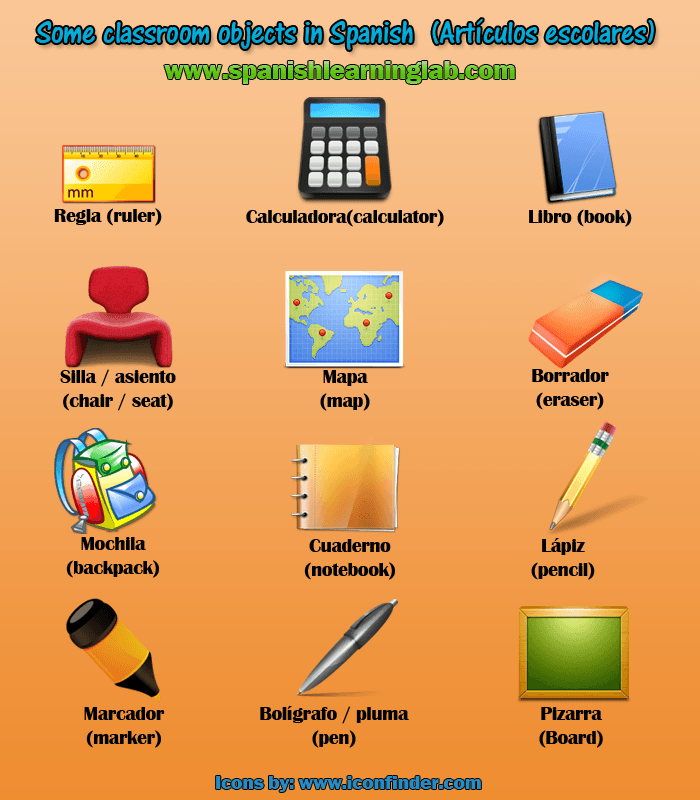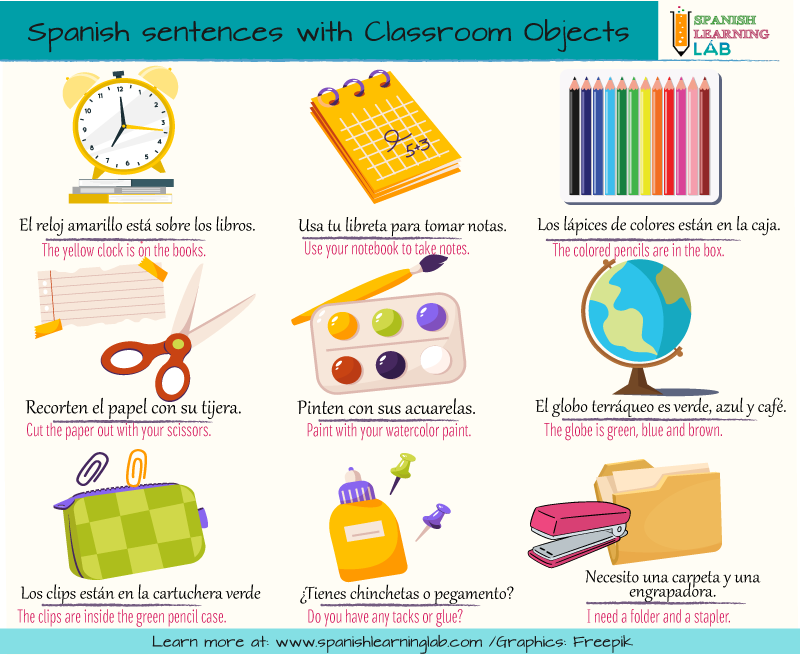The vocabulary for classroom objects in Spanish (los objetos de la clase) may be very useful at school and also in many other settings. In this lesson, you will read and listen to several examples using a list of classroom items. Besides, we will make use of the vocabulary and grammar structures we have covered in previous lessons such as colors, demonstrative adjectives, definite articles and the verbs SER and ESTAR. Let’s begin…
Vocabulary Introduction: A list of common classroom items in Spanish
First, we may refer to the things in classroom in Spanish as both “Los artículos del aula de clases” and “Los objetos de la clase“. Please take a look at this picture showing several of these items. We will see them in sentences later to hear their pronunciation and how they could be used in real contexts.

Hopefully you were able to recognize most of the items in the previous picture. We created the following video to help you learn more vocabulary on this topic. There are 26 different words for classroom objects in Spanish in the video, plus several examples of sentences. Take a look and learn a few extra words and phrases from it.
Making sentences with classroom objects in Spanish
Classroom items plus prepositions of place in Spanish
The first group of sentences will make use of prepositions of place(preposiciones de lugar) such as SOBRE (on), DEBAJO DE (under), ENCIMA DE (over), DENTRO DE (in or inside), FUERA DE (out or outside) y DETRÁS DE (behind). These prepositions were covered in a previous lesson, but as a reminder they are used along with the verb ESTAR in its forms ESTÁ (one object) and ESTÁN (several objects), just like in these three examples:
- “El libro está debajo de la silla“. (The book is under the chair.)
- “Los estudiantes están dentro del aula.” (The students are inside the classroom.)
- “Mi escritorio está frente a la pizarra.” (My desk is opposite to the whiteboard.)
We will also see demonstrative adjectives like ESE, ESA and so on in use as well as definite articles(EL, LA…) before many of these items. Read and listen to the following examples of sentences using a list of classroom objects in Spanish:
|
ESCRITORIO – El libro está sobre el escritorio amarillo
The book is on the yellow desk
|
|
MESA – El libro está debajo de la mesa anaranjada/naranja
The book is below the orange table
|
|
MAPA – Ese mapa verde está sobre la pared.
That green map is on the wall
|
|
BOLÍGRAFO – Estos bolígrafos están encima de la mesa.
These black pens are over the table
|
|
BORRADOR – Ese borrador rosado está detrás del librero.
That pink eraser is behind the bookshelf
|
|
MOCHILA – Este libro celeste está fuera de la mochila.
This sky blue book is outside the schoolbag
|
|
REGLA – La regla dorada está en medio de esos libros.
The gold ruler is between those books
|
|
CALCULADORA – La calculadora plateada está junto a esa mochila.
The silver calculator is next to that schoolbag
|
Classroom objects in Spanish plus the verb SER and colors
The second group of sentences with classroom items in Spanish will use colors and the verb SER. “Los colores” a special type of adjectives and they are always placed after the object (noun) we are describing. We do not say Un rosado borrador meaning a pink eraser, but Un borrador rosado. Now, the tricky part with colors is that they change their gender (feminine, masculine) and number (singular, plural) depending on the item or items they are describing, for example, REGLA is a feminine, singular noun so we would need a color that matches that gender and number like ROJA or VERDE so we can something like “Una regla roja”. This image below shows some sentences with colors and other useful verbs in the classroom:

If you want to talk about several classroom objects as in “three rulers”, then you should say “Tres reglas rojas” with the color and object in plural form. Colors are often placed directly after the noun they describe or after a form of the verb SER, commonly ES and SON. These two forms can also be used with adjectives to tell more about objects, for example: “viejo”(old), “nuevo”(new) and so on. Here are some more sentences using another list of classroom items in Spanish:
|
SILLA – Esa silla azul es muy cómoda
That blue seat/chair is very comfortable
|
|
COMPUTADORA -Esta computadora blanca es de buena marca.
This white computer has a good brand name.
|
|
PIZARRA – Estas pizarras son muy útiles
These whiteboards are very useful
|
|
LIBRERO – Aquel librero beige es viejo
That beige bookshelf is old
|
|
LÁPIZ – Este lápiz gris es un regalo
This gray pencil is a gift
|
|
MOCHILA – Esa mochila verde clara es muy bonita
That light green schoolbag is very beautiful
|
|
MARCADOR – Este marcador morado es muy útil.
This purple marker is very useful
|
Listening Activity: ¡Alistándose para ir a la escuela!
Key expressions in the conversation:
- “Tengo que llevarte a…” means “I have to take you to…”
- “¡Gracias por ayudarme!” means “Thanks for helping me!”

¿Dónde están mi calculadora? (Where is my calculator?)
¿Dónde está mi calculadora?. ……………….This should be corrected.
Yes, you are right! ¡Listo! Thanks for your help 🙂
MARCADOR – Este marcador morado es muy útil.
That purple marker is very useful.
Can you tell me why “este” in the above sentence is translated as “that?” Wouldn’t it be “Ese?”
Hola,
Actually, it is our mistake. ESTE means THIS so the right translation should be “This purple marker is very useful”.
Gracias 🙂
Alex,
Previously there was a quiz that included an audio selection that covered demonstrative adjectives and school supplies. It was a conversation between Mercedes and her father. Do you know where I can find it on the SLL website? I used that as an interpretive listening activity for a formative assessment. Thanks.
Hola,
Yes, we had a listening activity. I just updated the page and added the listening activity back. We had decided not to have this in the lesson but it was not a good idea lol. Thanks for asking. ¡Que tengas un buen día!:)